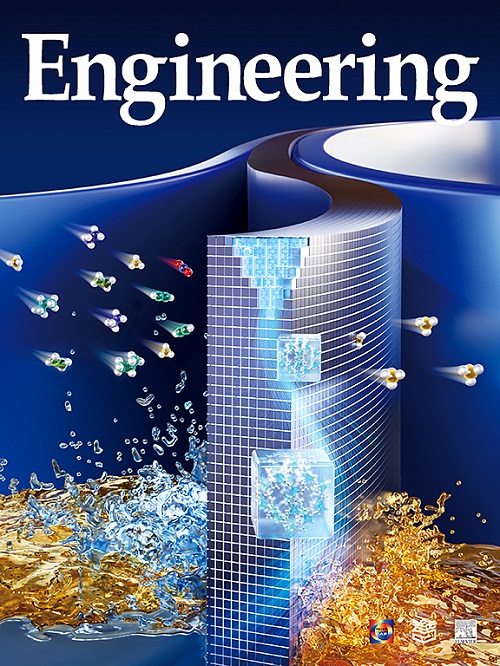基于中心对称离轴声涡同步演化的二维粒子装配
IF 10.1
1区 工程技术
Q1 ENGINEERING, MULTIDISCIPLINARY
引用次数: 0
摘要
声漩涡(AV)镊子可确保在零压中心稳定地捕获粒子,而两个漩涡核心之间的粒子组装仍受到高电位屏障的阻碍。虽然两个独立的圆柱形贝塞尔束之间的干涉可以构建出粒子集结的一维低压吸引路径,但在实际应用中,使用源阵列来创建二维(2D)邻近漩涡仍然具有挑战性。本文以平面声源环形阵列为基础,提出了一种二维粒子组装的三步相位反转策略,该策略基于具有预设径向偏移的 M 个离轴声漩涡(OA-AV)的中心对称阵列的同步演化。通过在漩涡阵列中引入 -2π/M 和 +2π/M 的初始漩涡相位差,在相邻 OA-AV 的切线状态前后,通过连接漩涡核心和场中心,形成了 M 边正多边形和 M 支星形的低压模式。由重合的同相位 OA-AV 构建的中心 AV 最终实现了面向中心的粒子组装。粒子在横向和径向的操纵能力通过在同步中心接近过程中指向场中心的声辐射力低压模式得到了证明。通过使用由 16 个平面声源组成的环形阵列对具有不同漩涡数、初始漩涡相位差和径向偏移的 OA-AV 进行实验场测量,证明了场的演变。在实验中,利用四边多边形、四枝星和中心 AV 的低压模式精确操纵四个粒子,也验证了在二维空间组装粒子的可行性。三步策略为基于中心对称 OA-AV 同步演化的二维粒子组装铺平了新的道路,使用简化的单面源阵列,为生物医学应用中细胞和粒子的精确导航和操纵展示了卓越的潜力。本文章由计算机程序翻译,如有差异,请以英文原文为准。
Two-Dimensional Particle Assembly Based on the Synchronized Evolution of Centrosymmetric Off-Axis Acoustic Vortexes
Acoustic-vortex (AV) tweezers ensure stable particle trapping at a zero-pressure center, while particle assembly between two vortex cores is still prevented by the high-potential barrier. Although a one-dimensional low-pressure attractive path of particle assembly can be constructed by the interference between two independent cylindrical Bessel beams, it remains challenging to create two-dimensional (2D) neighboring vortexes using a source array in practical applications. In this paper, a three-step phase-reversal strategy of 2D particle assembly based on the synchronized evolution of a centrosymmetric array of M off-axis acoustic vortexes (OA-AVs) with a preset radial offset is proposed based on a ring array of planar sources. By introducing initial vortex phase differences of −2π/M and +2π/M to the vortex array, low-pressure patterns of an M-sided regular polygon and M-branched star are formed by connecting the vortex cores and the field center before and after the tangent state of adjacent OA-AVs. Center-oriented particle assembly is finally realized by a central AV constructed by coincident in-phase OA-AVs. The capability of particle manipulation in the lateral and radial directions is demonstrated by low-pressure patterns with acoustic radiation forces pointing to the field center during a synchronized central approach. The field evolution is certified by experimental field measurements for OA-AVs with different vortex numbers, initial vortex phase differences, and radial offsets using a ring array of 16 planar sources. The feasibility of particle assembly in two dimensions is also verified by the accurate manipulation of four particles using the low-pressure patterns of a four-sided polygon, a four-branched star, and a central AV in experiments. The three-step strategy paves a new way for 2D particle assembly based on the synchronized evolution of centrosymmetric OA-AVs using a simplified single-sided source array, exhibiting excellent potential for the precise navigation and manipulation of cells and particles in biomedical applications.
求助全文
通过发布文献求助,成功后即可免费获取论文全文。
去求助
来源期刊

Engineering
Environmental Science-Environmental Engineering
自引率
1.60%
发文量
335
审稿时长
35 days
期刊介绍:
Engineering, an international open-access journal initiated by the Chinese Academy of Engineering (CAE) in 2015, serves as a distinguished platform for disseminating cutting-edge advancements in engineering R&D, sharing major research outputs, and highlighting key achievements worldwide. The journal's objectives encompass reporting progress in engineering science, fostering discussions on hot topics, addressing areas of interest, challenges, and prospects in engineering development, while considering human and environmental well-being and ethics in engineering. It aims to inspire breakthroughs and innovations with profound economic and social significance, propelling them to advanced international standards and transforming them into a new productive force. Ultimately, this endeavor seeks to bring about positive changes globally, benefit humanity, and shape a new future.
 求助内容:
求助内容: 应助结果提醒方式:
应助结果提醒方式:


